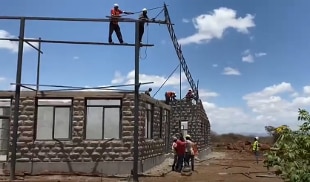Share
November 24, 2020
Covid-19 jeopardizes progress in the fight against female genital mutilation (FGM).
The estimates are staggering and cover the next ten years.
In the meantime, the United Nations is launching a global action starting from 25/11: 16 days of activism against gender-based violence.
Action to which Amref adheres.
"Covid-19 has put the fight against FGM to the test, but African communities are not giving up" says Paola Magni "proof of this is the good news of Nice Place"
FGM data
Every year 3.9 million girls are at risk of female genital mutilation (FGM).
At least 200 million women and girls in the world have suffered FGM and, among the victims, 44 million are girls up to 14 years of age.
FGMs concern more than 600,000 women and girls in Europe and 80,000 in Italy.
Pandemic consequences
Globally, COVID-19 threatens the results achieved so far in the fight to end FGM, and has a negative impact: according to the UNFPA report due to the limitations related to the current pandemic, a reduction of 1 is expected. / 3 of progress towards ending FGM by 2030. In addition, due to the COVID-19-related disruptions of many prevention programs, about two million cases of FGM could occur over the next decade that would otherwise have been avoided.
Good news
Nice Place is born, a place dreamed of by Nice Nailantei Leng'ete, operator and world ambassador of Amref Health Africa against female genital mutilation.
Her commitment also earned her international recognition by The Times as one of the 100 most influential people in the world.
The "Nice Place" is a project born in Kenya in 2019, aimed at establishing a safe place where girls can go when threatened by FGM or forced marriage at an early age.
It will function as a Reception Center and a Girls Academy under one roof.
In this place, girls will receive training in life strategies, leadership and entrepreneurial skills, making themselves independent and minimizing the addiction syndrome at the community level.
The Girls Academy, at the moment, has the possibility to host 50 girls every year, while the Reception Center will be open to every girl, girl or woman who will need protection.
“Nice Place” wants to represent a place where girls can acquire strength and skills.
It will be a circular construction with a large square in the center.
Despite the setbacks caused by COVID, the work is progressing: the walls have been built. "Leading the Amref Health Africa project in Kenya with the support of Amref Holland and Amref Italia.
Impact
To date, between Kenya and Tanzania, they are over 20,000 girls saved directly, through the Alternative Rites of Passage - rites that mark the passage of girls to adulthood, but banning mutilation. Overall, about 500,000 women and girls have benefited from the Amref projects between Tanzania, Kenya, Ethiopia, Uganda, Malawi and Senegal, both directly and indirectly. In the county of Kajiado (Kenya) alone, the action of Amref has caused FGM to decrease by 24% since 2009.
The overwhelming force of Nice and the African communities
"One day, while I was teaching at school, I noticed that some girls were missing from class - says Sarah Koimerek, Kenyan teacher - When I asked for information, I learned that they had undergone the ta
female genital child.
I watched in horror at the suffering of these girls who developed complications.
Furthermore, their parents could not take them to the hospital for treatment for fear of being arrested.
This is what prompted me to get interested in Amref's work ”.
Next to them are men of the police, village leaders and young warriors.
"We must intensify our efforts" says Paola Magni of Amref Italia "this is why we joined the United Nations campaign and from 25/11, for sixteen days, we will tell success stories, against a violence that we aim to defeat by 2030. The communities Africans are ready and have the strength to do so ”.
Amref is also involved through two global networks - Global Platform for Action to End FGM / C and Girls not brides - to make FGM “a practice of the past”.

